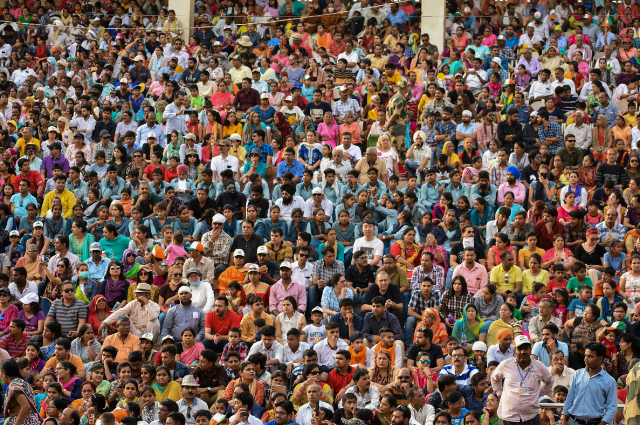
Photo by Brady Bellini on Unsplash
On a planet of over 190 countries, two Asian giants—India and China—hold nearly 4 out of every 10 people alive today. Isn’t it strange that despite Earth’s vast landmass, population density is so skewed? Is this just a coincidence, or is it the result of some historical, geographical, and cultural forces working over thousands of years?
A Historical Foundation: The Cradle of Civilization
India and China host such large populations today in their historical continuity as densely inhabited regions dating back thousands. Long before modern nation-states existed, both these regions were home to some of the earliest and most advanced civilizations in human history.
The Indus Valley and Yellow River Civilizations
In India, the Indus Valley Civilization (IVC), which emerged around 3300 BCE, was one of the world’s earliest and most advanced urban cultures, renowned for its meticulously planned cities, elaborate drainage systems, and extensive trade networks. At its peak, the IVC supported up to 140 million people, accounting for nearly a fifth of the global population at the time.
Simultaneously, in China, civilizations thrived along the Yellow and Yangtze Rivers, developing tools, rice farming, bronze work, and structured governance. These civilizations sustained tens of millions, laying the demographic foundation for future growth and development.
This early start in urban and agricultural development gave both nations a head start in population accumulation compared to many other parts of the world, where nomadic or hunter-gatherer lifestyles persisted for much longer.
Geography: Nature’s Blessing
Population growth doesn’t happen in a vacuum. Geography plays a massive role in deciding whether a region is livable, cultivable, and sustainable. Both India and China were blessed in this regard.
Natural Barriers and Favorable Climates
India has the Himalayas to the north, while China benefits from the Changbai Mountains in its northeast. These mountain ranges served two key purposes:
- Protection from extreme climates (such as cold Siberian winds).
- Rain-bearing winds retention, ensuring a reliable monsoon season.
As a result, these regions maintained a temperate and habitable climate, ideal for human settlement.
Water Abundance and River Systems
Both countries boast intricate networks of rivers:
- India has over 400 major rivers, including the Ganges, Yamuna, Brahmaputra, and Godavari.
- China is fed by the Yangtze, Yellow, Pearl, and Mekong Rivers.
These rivers not only provided drinking water but also enabled irrigation, trade, and transportation, all of which are vital to supporting large human populations.
Fertile Alluvial Soil
Thanks to regular monsoons and river flooding, both nations developed highly fertile alluvial plains. From the Indo-Gangetic plains in India to the North China Plain, the soil in these areas is ideal for large-scale agriculture, which directly translates to food security—the first ingredient in population growth.
Agricultural Innovation: The Rice Revolution
Rice as a Game-Changer
The domestication of rice was one of the most transformative developments in both Indian and Chinese history. Unlike wheat or barley, rice can feed far more people per hectare. It is:
- Rich in calories
- Highly productive in suitable climates
- Easily storable and tradable
Rice allowed these societies to shift from subsistence to surplus economies. More food meant:
Fewer deaths from starvation
- Larger families
- The ability to support non-farming roles like artisans, soldiers, and traders
Labor-Intensive Farming and Bigger Families
Ironically, the labor-intensive nature of rice farming also contributed to population growth. Families often had more children to help in the fields. This created a cyclical effect:
More food → more children → more labor → more food
Cultural Continuity Amid Invasions and Migration
India: A Land of Invaders, Yet a Land of Absorption
From the Persians and Greeks to the Mughals and British, India saw over 200 invasions between 580 BCE and 1947. Yet, many of these invaders settled in India, intermarried with locals, and contributed to its population and culture.
Despite famines, plagues, and wars, India maintained demographic resilience.
China: Protected and Unified
China also faced invasions, most notably from the Mongols and the Japanese. However, the Great Wall of China and a strong central bureaucracy often minimized large-scale demographic disruption. China also absorbed various ethnic groups over time, expanding its diversity and labor force.
The result: Both countries were able to bounce back from population losses, unlike regions like Europe (Black Death) or the Middle East (Mongol invasions), which experienced sharp population collapses.
Colonialism, Wars, and the Demographic Balance
A Look at the 20th Century
Post World Wars I and II, Europe and Japan suffered massive demographic setbacks. In contrast:
- China, under Mao Zedong, actively promoted childbirth.
- India, following independence, encouraged population growth indirectly through rural development and later through agricultural revolutions.
Meanwhile, birth control pills, urbanization, and changing lifestyles led to drastic reductions in birth rates in the West.
Green and White Revolutions in India
In the 1960s and 1970s, India’s Green Revolution improved wheat and rice yields, while the White Revolution boosted milk production. These increased food security and rural income, creating conditions for even larger families, especially in agricultural regions.
The Present Scenario: Population as a Double-Edged Sword
India Surpasses China

Photo by Neelakshi Singh on Unsplash
In recent years, India has overtaken China to become the most populous country in the world. However, with this title comes both opportunity and challenge:
- Pros: Demographic dividend, youthful population, large consumer base.
- Cons: Poverty, unemployment, pressure on natural resources, and governance hurdles.
Developed countries like Japan, South Korea, and much of Europe are grappling with aging populations and labor shortages. In contrast, India has over 808 million youth under the age of 35.
This is a massive human resource base, but only if educated, skilled, and employed productively.
India and China’s population growth is not a fluke—it is the result of a rich confluence of geography, history, culture, and resilience. These nations have weathered invasions, famines, and political upheavals, emerging as the world’s most populous countries through thousands of years of continuity.
Today, they sit at a crossroads. One has already slowed its growth (China), while the other is peaking (India). The question is no longer “Why so many people?”—but “What will we do with so many people?”
If India can channel the energy of its youth, learn from its past, and invest in its future, it won’t just be the most populated country—it might just become the most powerful.
